What the future of voice really means for your brand
Many brands are now jostling to dip their toes in the water with voice assistants. But before they go much further, brand owners must build a view of how voice will evolve and the implications for marketing.

The future of voice
Amazon and Google are both committed to investing more money and energy into growing voice penetration –launching investment programs for early-stage startups to build their respective digital assistant ecosystems. And Facebook smart speakers Aloha and Fiona are expected to launch by July 1st. Further growth of voice is assured but it’s less clear just how voice will ‘look’. The answer, however, will be shaped by these key trends.
First, voice will be ubiquitous. It won’t be a premium in-car or in-home feature but standard – just look at the spread of voice UI into a growing array of domestic products. As this continues, people will adapt to (and become adept at) speaking to many different types of products from fridges to lights while some of the products they replace, such as phones in bedrooms, may decline.
Second, voice will change how we shop. Rapid growth in voice shopping is expected, and is predicted to hit £3.5bn by 2022, according to OC&C Strategy. For now, the majority of voice shopping is to re-order or build shopping lists. Consumer familiarity with visual aids such as the Echo Show will only further accelerate adoption.
Furthermore, once in-home and in-car digital voice assistants are more closely linked, a shopper’s location can be tracked and product delivery co-ordinated so that a purchased item arrives only when they are at home.
Third, a brand’s voice will become as recognizable as its logo. Voice branding will be an essential tool for a brand owner to stand out from its competition – not just by being aurally distinctive, but by using voice in order to trigger the deeper emotional connections needed to drive greater brand affinity. In a recent trial, we tested responses to an ‘own brand’ voice versus Alexa for voice interaction with branded content. When the interaction anticipated is longer-form and conversational rather than brief and transactional, the superior engagement that can be achieved with an ‘own brand’ voice was clear.
Fourth, voice will change how we search. The future of voice search will enable consumers to have a conversation with a voice assistant if the initial query is ambiguous. The voice assistant will begin to understand intent for specific queries, such as ‘which birthday cake I should make for my son’s birthday?’, and return a personalized result based upon the consumer’s profile. Assistants will also make proactive recommendations based on previous searches, key calendar dates and shopping behavior.
Finally, there will be a much-needed evolution towards a more sophisticated approach to voice analytics. Right now, voice analytics is a standalone, siloed dataset. In the near future, a more joined-up view will emerge, enabling brand owners to identify and action according to a single, seamless voice journey across all on and offline touchpoints.
For brands, the voice future – which, in fact, is not so very distant – requires action today. The market adoption will be driven by how smart the assistant becomes, and brands must become smart about the way they reach their consumers with voice.
They also need to think specifically how voice can best be integrated into their products. Alexa’s artificial intelligence doesn’t appear to recognize brand value, therefore brands need to look at how they drive awareness in the priming stage. The answer lies in developing a voice to drive the deepest levels of emotional connection while investing in innovation around voice search – we recently built a voice application on Amazon that has since become the default answer to many queries.
Voice will only become more prevalent so brands need to act now to make the most of the opportunities it offers in terms of shopping, branding and search. Those that make the commitment to a test and learn approach won’t regret it.
Sarah Salter, head of innovation, Wavemaker
Web: www.wavemakerglobal.com
Twitter: @wavemakeruk

